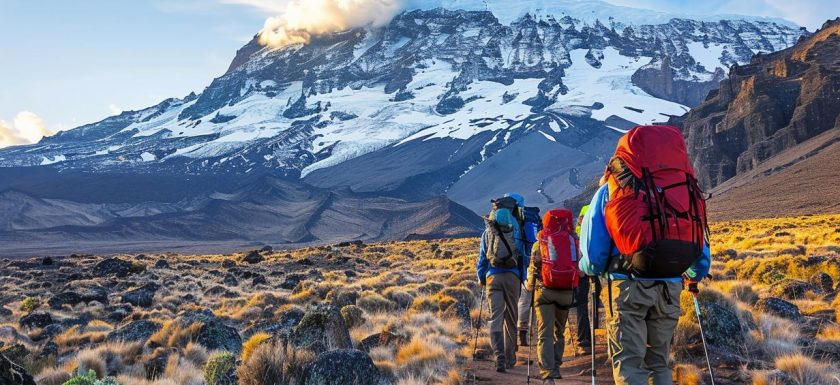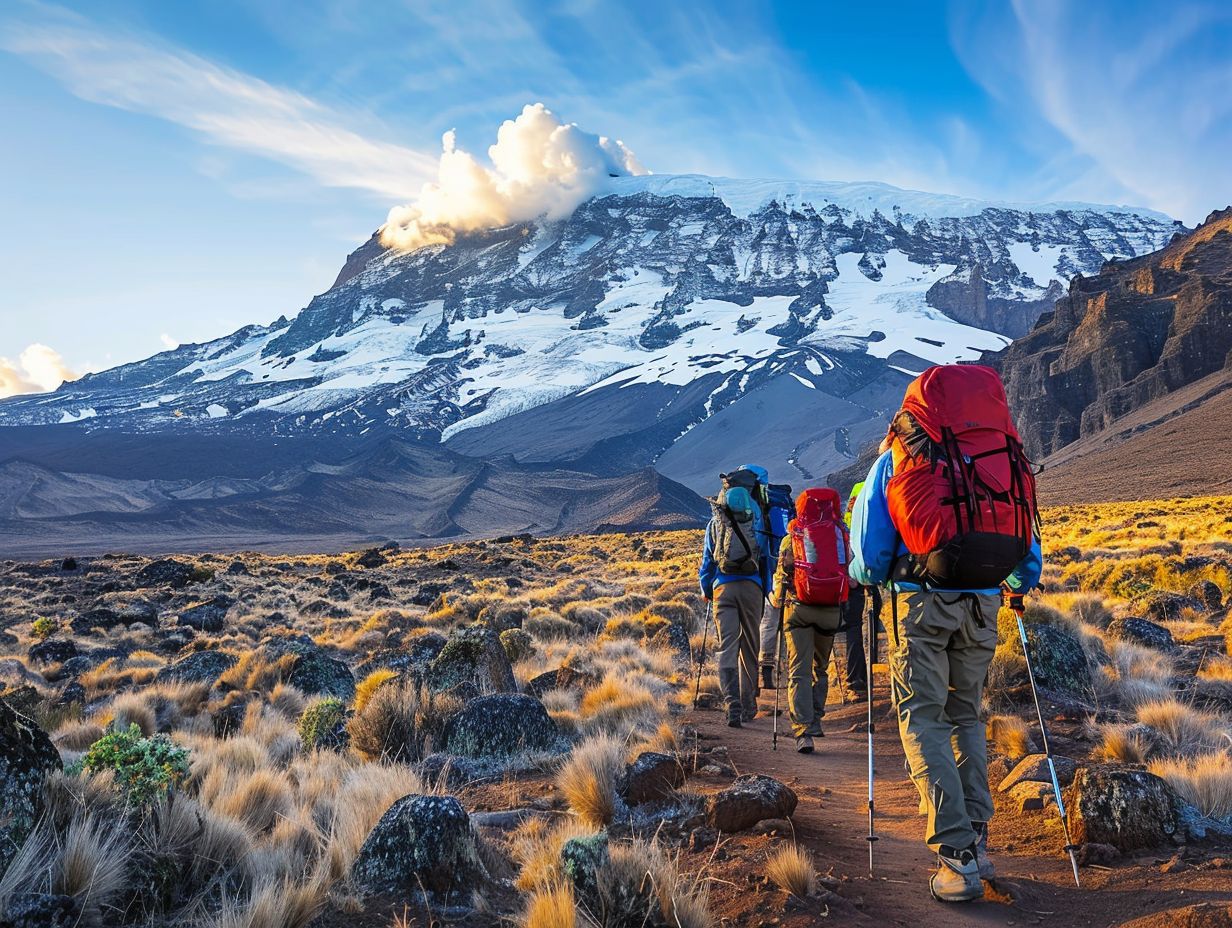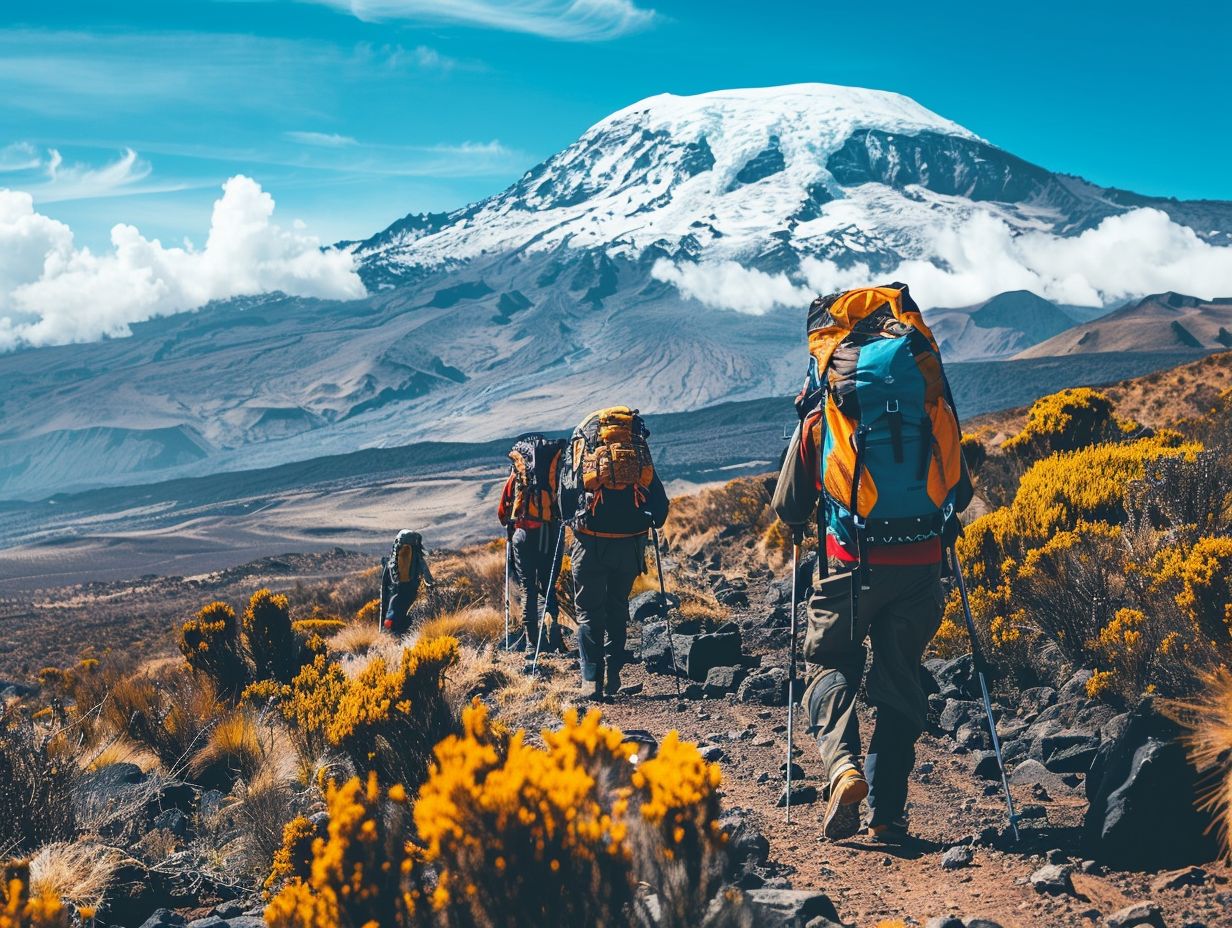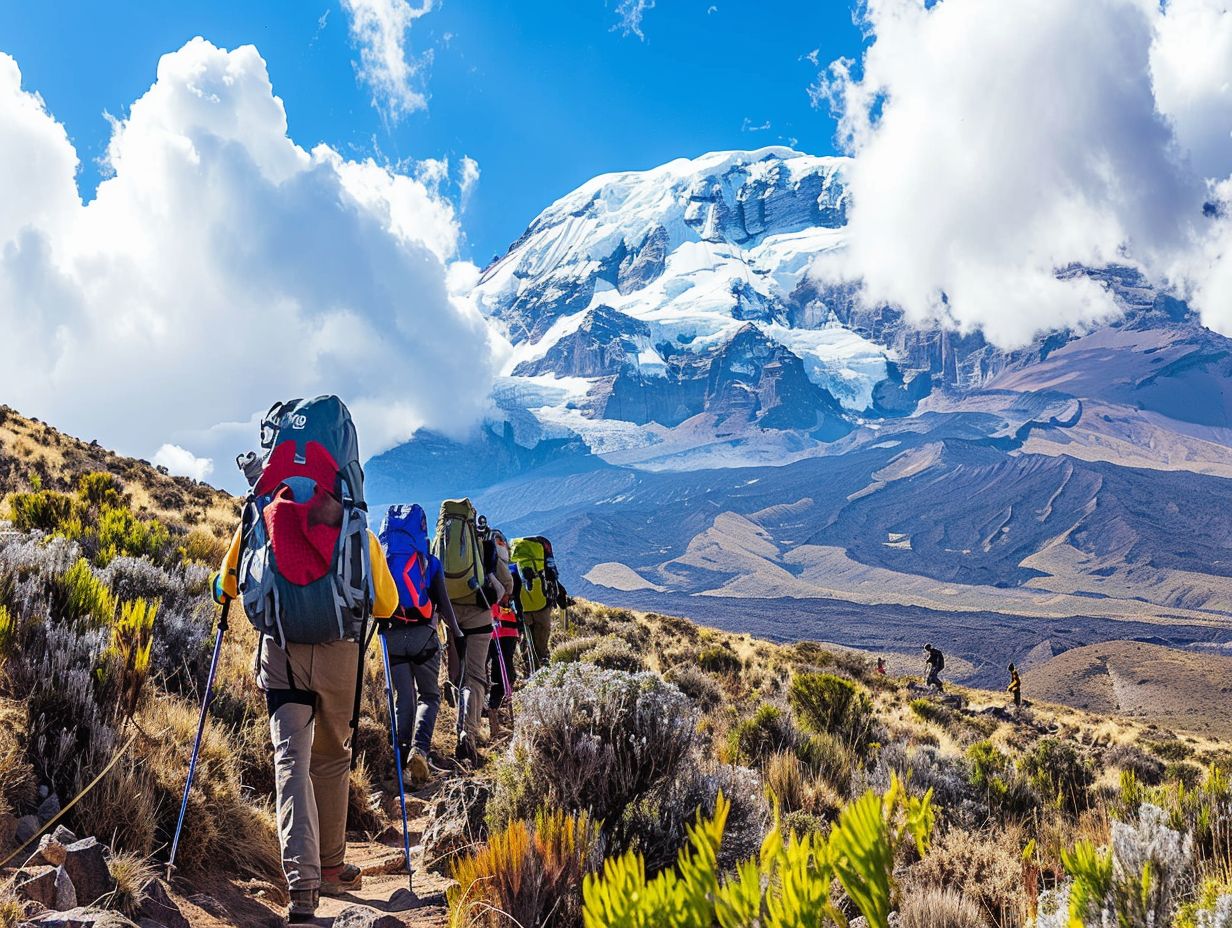
Are you planning to climb Mount Kilimanjaro but worried about altitude sickness?
We will discuss the different Kilimanjaro routes and how altitude sickness can affect climbers.
Explore the symptoms of altitude sickness and factors that contribute to it.
Learn about the best Kilimanjaro routes for altitude sickness and get valuable tips on how to prevent it during your climb.
Whether you’re a seasoned climber or a first-timer, this guide has got you covered.
Key Takeaways:

- The Machame, Lemosho, Rongai, and Northern Circuit routes are the best Kilimanjaro routes for altitude sickness due to their longer itineraries and gradual altitude gain.
- Altitude sickness can affect climbers on Kilimanjaro due to the high altitude, rapid ascent, and individual factors.
- To prevent altitude sickness, climbers should acclimatize properly, stay hydrated, take it slow, and consider using medication if necessary.
Best Kilimanjaro Routes for Altitude Sickness
Choosing the best Kilimanjaro route for altitude sickness management involves selecting routes like Machame, Lemosho, Rongai, or Northern Circuit that offer gradual ascent, ample rest days, and a ‘Pole Pole’ (slow) trekking pace to aid in acclimatization.
Machame Route
The Machame Route on Kilimanjaro is popular for its excellent acclimatization profile, allowing climbers to adapt gradually to the increasing altitudes and reducing the risk of AMS symptoms along the way.
Known as the ‘Whiskey Route’ due to its steep ascents and descents, the Machame Route offers stunning scenery as climbers traverse diverse landscapes, from lush rainforests to alpine deserts. A key highlight of this route is the scenic Shira Plateau, providing awe-inspiring panoramic views of the surrounding peaks.
With a more gradual climb profile, hikers have higher chances of acclimatizing effectively, minimizing altitude sickness. Proper hydration and pacing are essential on the Machame Route, allowing trekkers to comfortably adjust to the increasing altitudes.
Lemosho Route

The Lemosho Route stands out for its longer duration, providing more time for altitude training and acclimatization, which contributes to better oxygen utilization and reduced altitude sickness risks for climbers.
Plus the extended itinerary, the Lemosho Route also boasts varying landscapes, from lush rainforests to alpine desert terrains, offering climbers a diverse and scenic journey. This route provides ample opportunities for trekkers to adapt to the increasing altitudes gradually, enhancing their chances of a successful summit.
The variation in the route allows climbers to experience different climatic conditions, further aiding in acclimatization. The higher oxygen availability in the atmosphere as compared to other trails is another advantage of the Lemosho Route, making it an attractive choice for those prone to altitude sickness.
Rongai Route
The Rongai Route offers a more gradual ascent profile, allowing climbers to take a slow trek to higher altitudes, facilitating better acclimatization and oxygen intake to combat altitude sickness effectively.
The slow trekking pace of the Rongai Route is a key feature that sets it apart from other climbing routes on Mount Kilimanjaro. This gentle progression not only reduces the risk of altitude-related illnesses but also enhances the overall experience by giving climbers more time to enjoy the stunning scenery.
The gradual increase in altitude provides the body with ample time to adjust to the changing oxygen levels, significantly lowering the chances of altitude sickness. Climbers benefit from natural oxygen supply considerations along the route, aiding in the prevention of hypoxia and related symptoms.
Northern Circuit Route
The Northern Circuit Route is renowned for its extended duration and superior acclimatization opportunities, enabling climbers to manage AMS symptoms effectively and safely progress to the summit of Kilimanjaro.
One of the key advantages of the Northern Circuit Route is the gradual ascent it offers, allowing climbers to acclimatize slowly and reduce the risk of altitude sickness.
This extended duration not only aids in symptom management but also enhances the overall climbing experience by providing opportunities to enjoy diverse landscapes and wildlife along the way.
The route allows for adequate rest periods at various high-altitude camps, allowing climbers to adjust to the changing conditions and reduce the likelihood of experiencing severe AMS symptoms.
The slower pace of the Northern Circuit Route is particularly beneficial for those susceptible to altitude sickness, ensuring a safer and more enjoyable climb.
Tips for Preventing Altitude Sickness on Kilimanjaro
To prevent altitude sickness on Kilimanjaro, climbers should prioritize proper acclimatization, stay hydrated, maintain a slow trekking pace, and consider using medications like Diamox to aid in altitude adaptation and oxygen intake.
Acclimatize Properly
Proper acclimatization involves taking sufficient rest days, ascending gradually, and recognizing early AMS symptoms to adjust the climbing pace accordingly. Adequate acclimatization is key to a successful Kilimanjaro ascent.
Acclimatizing to high altitudes like those experienced on the Kilimanjaro trek requires careful planning and mindful adjustments to ensure the body can cope with reduced oxygen levels.
Rest days are essential as they allow the body to adapt, giving it time to produce more red blood cells and increase oxygen-carrying capacity, vital for sustained energy.
An incremental climb strategy helps hikers avoid altitude sickness by acclimating to higher elevations slowly, aiding in preventing symptoms like headaches, nausea, and fatigue.
Stay Hydrated
Staying hydrated at high altitudes is essential to combat dehydration, which can exacerbate altitude sickness symptoms. Climbers should drink plenty of water throughout the ascent on Kilimanjaro.
Dehydration at high elevations poses significant risks, as the dry mountain air and increased respiratory rate lead to a higher rate of fluid loss through respiration and sweat. Proper hydration is crucial in maintaining blood volume and oxygen delivery to tissues, helping to prevent altitude-related illnesses.
It is recommended for climbers to consume at least 3-4 liters of water daily while ascending, and to avoid excess caffeine and alcohol consumption, which can contribute to dehydration. Paying attention to signs of dehydration such as dark urine or dry mouth is key to staying healthy and safe during the ascent.
Take it Slow

Adopting a ‘Pole Pole’ (slowly, slowly) approach to trekking on Kilimanjaro allows for better altitude training, improved acclimatization, and reduced strain on the body, lowering the risk of altitude sickness.
By moving at a leisurely pace, climbers give their bodies the necessary time to adapt to the decreasing oxygen levels, aiding in the process of acclimatization. This gradual ascent helps mitigate the typical symptoms of altitude sickness such as headaches, fatigue, and nausea, ensuring a smoother experience on the mountain.
The ‘Pole Pole’ technique not only benefits physical adaptation but also enhances the overall climbing journey by allowing trekkers to appreciate the stunning landscapes, interact with local communities, and savor the unique flora and fauna found along the route.
Use Medication if Necessary
In cases where altitude sickness symptoms persist or worsen, climbers may consider using medications like Diamox to aid in acclimatization and improve oxygen uptake at high altitudes. Consultation with a healthcare professional is recommended.
Diamox, also known as Acetazolamide, is a common medication prescribed for altitude sickness due to its ability to help the body adjust to higher altitudes more effectively. It works by increasing the amount of alkali in the kidneys, which leads to more bicarbonate being excreted in the urine. This process helps to make the blood more acidic, stimulating breathing and improving oxygen levels.
While Diamox can be beneficial in preventing altitude sickness, it is essential to be aware of potential side effects such as increased urination, tingling sensations, and taste alterations. These side effects are usually mild but should be monitored during use.
Climbers planning to ascend Kilimanjaro or engage in other high-altitude activities should consult their healthcare provider to discuss the appropriate dosage and usage guidelines for Diamox. It is important to start the medication a day or two before ascending and continue taking it during the ascent to maximize its effectiveness in acclimatization.
Staying well-hydrated, avoiding alcohol and heavy exertion, and following a gradual ascent schedule are crucial complements to medication usage in altitude sickness prevention.
A combination of proper medication use, hydration, and acclimatization strategies can significantly enhance climbers’ safety and enjoyment of high-altitude adventures like summiting Kilimanjaro.
Frequently Asked Questions
What is the best Kilimanjaro route for avoiding altitude sickness?
The best Kilimanjaro route for avoiding altitude sickness is the Marangu route. It has a gradual ascent, giving your body more time to acclimatize to the increasing altitude. It also has a higher success rate due to the longer duration of the trek.
Which Kilimanjaro route should I avoid if I am prone to altitude sickness?
If you are prone to altitude sickness, it is best to avoid the Rongai and Northern Circuit routes. These routes have a steep ascent and may cause symptoms of altitude sickness to worsen. The Machame route is another option to avoid, as it has a rapid ascent that can be challenging for those prone to altitude sickness.
Are there any specific precautions I should take to avoid altitude sickness on the Kilimanjaro route?
Yes, there are several precautions you can take to avoid altitude sickness on the Kilimanjaro route. Firstly, make sure to drink plenty of fluids and stay hydrated. Also, consider taking Diamox or another medication to help with acclimatization. It is also essential to pace yourself and listen to your body, taking breaks when needed.
Is it possible to experience altitude sickness on the Kilimanjaro route?
Yes, it is possible to experience altitude sickness on the Kilimanjaro route. Altitude sickness can affect anyone, regardless of age, fitness level, or previous trekking experience. It is crucial to be aware of the symptoms and take appropriate measures to prevent or treat altitude sickness.
Are there any factors that can increase the risk of altitude sickness on the Kilimanjaro route?
Yes, there are several factors that can increase the risk of altitude sickness on the Kilimanjaro route. These include a rapid ascent, inadequate acclimatization, dehydration, and underlying health conditions such as heart or lung problems. It is essential to plan and prepare for these factors when choosing a route.
What should I do if I experience symptoms of altitude sickness on the Kilimanjaro route?
If you experience symptoms of altitude sickness on the Kilimanjaro route, it is crucial to communicate with your guide and take their advice. They may recommend descending to a lower altitude, resting, or taking medication. It is essential to take symptoms seriously and not push yourself beyond your limits to prevent further complications.